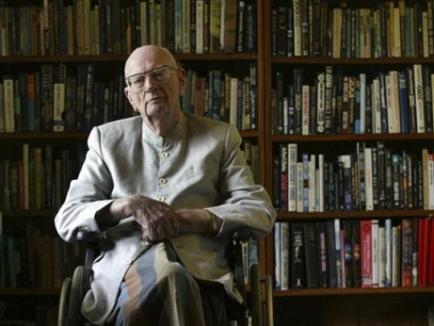On March 19th 2008, Sir Arthur C. Clarke passed away in his adopted home of Colombo, Sri Lanka. The nonagenarian left behind a stupendous legacy. He was at once an author, inventor, futurist, visionary, mathematician, pilot, radar specialist, nature lover, scuba diver and underwater explorer. To categorize him as any single one of these would be an injustice to his myriad talents.
As a science fiction writer, he was par excellence. He made his name dealing with space adventures and alien civilisations. His fertile imagination, grounded in an unshakeable knowledge of astrophysics, put him in a league of his own. With a penchant for the cosmic, a vast repertoire of knowledge, and an ability to see things before they became visible, Clarke was quite simply a visionary. He was the man who saw forever.
Arthur Charles Clarke was born in Somerset, England, in 1917. He had the same humble beginning of any astrophysicist: stargazing. The young Clarke showed an avid interest in American science fiction magazines, which whetted his appetite.
Unable to afford a university education, Clarke joined the Royal Air Force after his secondary education. He served in several capacities, such as Radar Specialist, Pilot Officer, Flying Officer and Flight Lieutenant. After the Second World War, he earned a first class degree in physics and mathematics from King’s College, London. He served in the British Interplanetary Society.
Clarke started writing to scientific magazines such as Wireless World. In 1948, he wrote a short story called “The Sentinel” for a BBC competition. The story was rejected, but went on to be a turning point in Clarke’s career. It introduced a mystic and cosmic element to Clarke’s work, an element which would define him forever. He wrote his first novel, Prelude To Space, in 1951, and there was no turning back. He later wrote over 30 novels and 20 non-fiction books.
He wrote The Fountains of Paradise, portraying a space elevator leading from earth to a space station. Rendezvous With Rama depicted an alien spaceship mistaken for an asteroid and named after the Hindu god Rama. The Sands of Mars described a human colony on Mars, where colonists adopt numerous scientifically believable techniques to make the planet inhabitable. Dolphin Island was inspired by his adventures as an underwater explorer. The Hammer of God depicted a religious sect attempting to convert humans into terabytes of computer information.
He is most famous for his 1968 novel, 2001: A Space Odyssey, about an ancient and unseen alien race performing evolutionary experiments with humanity. The aliens use devices with the appearance of large crystal monoliths to investigate faraway worlds, and if possible, encourage intelligent life there. It revolves around Captain Bowman, who is drawn into one of those monoliths and turned into an immortal “star child”, charged with the task of coming back to earth and catalysing evolution. The novel was simultaneously made into a movie by director Stanley Kubrick. Clarke followed 2001: A Space Odyssey with three sequels.
His contributions were more than just literary. His vision proved to be the catalyst for two important technological breakthroughs of the 20th century. He was the first to suggest that geostationary satellites could be ideal telecommunications relays facilitating near-instantaneous transmissions. He conceived this in 1945, and saw his dream bear fruit barely 20 years later. His prediction that man would set foot on the moon by 2000 was a driving force motivating NASA to realize the vision as early as 1969.
He was human though, and some of his predictions went off the mark. He cheekily predicted that humans would use apes as household servants by the end of the 20th century. He also warned us that the apes will form unions and create a ruckus!
Compared to Clarke’s other achievements, his formulation of the Three Laws of Prediction may seem a little trivial. But they are noteworthy for their sheer wit.
1. When a distinguished but elderly scientist states that something is possible, he is almost certainly right. When he states that something is impossible, he is very probably wrong.
2. The only way of discovering the limits of the possible is to venture a little way past them into the impossible.
3. Any sufficiently advanced technology is indistinguishable from magic.
He later formulated a fourth one:
4. For every expert there is an equal and opposite expert.
In 2007, Clarke completed 90 orbits around the sun. He was now in a wheelchair, but his mind continued to reach the farthest outposts of the universe. He marked his 90th birthday by speaking to his followers through a Youtube video. He expressed three birthday wishes: For ET to call, for mankind to quit his addiction to oil, and for lasting peace in Sri Lanka. He could not resist making more predictions. He declared this the beginning of the golden age of space travel. He predicted that thousands of space tourists will travel to the moon and beyond within the next 30 years.
In 2001: A Space Odyssey, Captain Bowman attains the status of an immortal star child, and is sent back to earth to inspire evolutionary leaps. That may well describe Arthur C. Clarke himself. Evolutionary catalyst, immortal star child.

